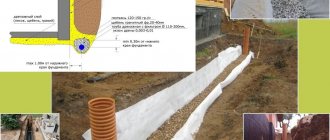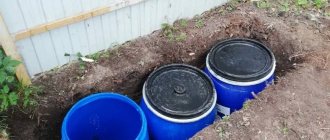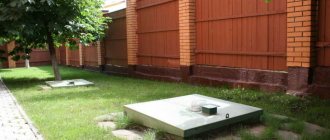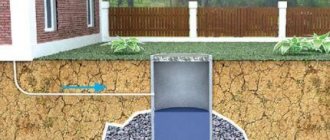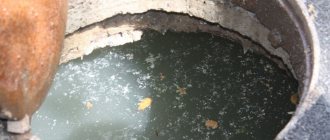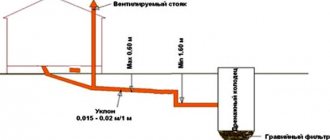Living in a private house requires the presence of an autonomous sewer system. It consists of internal wiring, external piping and a storage tank (or VOC). For residents of holiday villages or houses of temporary (seasonal) residence, a cesspool remains relevant as the best way to collect and partially recycle waste.
We will tell independent home craftsmen how to construct a cesspool from a barrel. This is an extremely simple option that requires a minimum of funds in construction. Taking into account our recommendations, you can easily install an autonomous sewer system with a cesspool.
How is a cesspool different from a septic tank?
Previously, the word “septic tank” was unknown, and the role of the only possible place for collecting waste was played by a cesspool.
Structurally, all cesspools were similar, the difference concerned the presence or absence of any container. Often, an ordinary hole was dug in the ground, and a wooden birdhouse was built above it. Such outdoor toilets can still be found in old holiday villages.
A modern version of a toilet that is located “in the yard” is a beautiful house, neatly painted and decorated with flowers. A sewer container with a neck for pumping is buried under it.
A pit without a sealed container is an environmental threat to a garden plot. If home owners are interested in clean soil and water, they must place a reservoir in the cesspool pit.
Previously, it was made of boards or bricks, now - from concrete rings or monolithic concrete. Barrels, metal or plastic, specially designed for sewage systems are also often used.
Even a large sealed tank made of modified plastic is just a storage tank that fills quickly and requires regular pumping. It is for this reason that cesspools are absolutely not suitable for family cottages.
Image gallery
Photo from
Country sewerage using barrels
Barrel as a storage container
Application of plastic containers
Eurocubes as a sump tank
To make the sewer system more efficient, instead of a cesspool, a septic tank is installed, which not only collects wastewater, but partially purifies it. Pumping out solid sediment from a septic tank is done much less frequently than from a pit.
A volumetric container made of modified plastic is the best option for a cesspool. A large tank with a volume of 6-8 m³ can easily replace 3-4 standard metal barrels
The installation of biological treatment stations is recognized as the most advanced method for collecting and processing sewage. Thanks to the special design and operating principle, the block, consisting of several sections, purifies liquid up to 98%.
After such thorough filtration, the water goes into a reservoir, into the ground or into a storage well for household needs.
Best answers
Ruff:
You can do whatever you want, who will stop you? ! ))) I will suggest such options. 1. Make drainage around the foundation of the house. Dig a hole 60 cm deep around the perimeter, put crushed stone and sand on the bottom, put a thick drainage pipe with holes wrapped in geotextile. When laying, observe slopes. To lead this pipe into the drainage well - dig a hole with 2-3 rings in a low corner of the site, place concrete rings there and bring out the drainage pipe, cover the top with a lid, DO NOT concrete the bottom. We did this at one dacha; we use water from this well for irrigation. It doesn’t freeze in winter, the ice is only on top, everything is fine. 2. Direct the drains under the roof of the house and the vertical drainage pipe (it’s still better to move it away from the foundation) to a certain place in the ground. And in this place, bury either a leaky barrel or a leaky basin filled with crushed stone. Then the barrels will not be an eyesore, and the water will go into the ground through this filter without waterlogging the soil. 3. Take the pipes away from the roof gutters, either with pipes or hoses, into any container you like, closer to the garden. But this system will not decorate the site, although it is convenient from an engineering point of view. 4. Nowadays they sell rainwater containers decorated to look like anything. Under Greek columns, under oak trunks, etc. In any case, your container will have to be emptied of water for the winter, as far as it is convenient for you... And think about it so that no one falls through or drowns there - not yourself, not a mouse, not a cat, not a grandmother, not a grandfather, not a granddaughter, not a bug...
Luke:
Of course, I did this in case of nuclear war :))))
Athena:
of course it is possible.
Veniamin Badzinsky:
It is possible, but first cover it with bitumen mastic to protect it from rust (the paint will be rather weak).
Ilmer:
Can. But there is only one problem: if you leave it like that for the winter, it will burst from the water inside.
Andrey Alekseev:
You can bury it by first waterproofing the container. but the water will fade
panina:
The previous owners of the dacha buried the barrel in the ground almost up to their ears. There is no way to pump out water. The rest of the barrels, just standing on the ground and buried a quarter of the way, have become leaky a long time ago, but the one buried in its entirety is still alive.
Valentina Timofeeva:
the water in such a barrel will not warm up
Elena Orlova:
Can . but it will cool down and you will water (if for watering) with cold water
Galina Volokovykh:
We collect water from under the barn in a buried barrel in the spring. We collect water in large bottles and put it in the greenhouse. then we water the seedlings. as long as a lot of water is not required. The barrel is rusty. but it is still useful. Mice also fall into it and die.
Lisa Halanay:
And we have a steel tank of 6 cubic meters standing on “legs” concreted into the ground a meter deep, with a man-sized shed underneath for small things. The tank was overgrown with roses and mulberries. We never drain the water in the winter; we simply place a thick board vertically so that the ice does not burst the walls of the tank. The water in the tank is warm, heated by the sun. A fitting with a tap is welded near the bottom; you can water the garden with a hose. Baku is 23 years old, as is the vegetable garden.
Benefits of raking out a barrel
If, for financial or other reasons, you cannot install a septic tank (a more efficient treatment facility), you will have to install a cesspool.
You should immediately abandon the option that does not involve installing a container. Sewage that has not undergone the decomposition process and immediately enters the ground and groundwater contains dangerous microorganisms. Over time, they can pollute fertile soil, well water, and cultivated plants in the garden.
Therefore, before installing a cesspool, you need to decide on the type of tank, that is, choose one of the following options:
- brick well;
- well made of concrete rings;
- pit made of rubber tires;
- monolithic concrete tank;
- plastic container or metal barrel.
The cheapest, but least reliable, is considered to be a well made from old car tires. It requires high-quality waterproofing and is not suitable for bulk sewer drains. A brick structure is too labor-intensive and also requires careful sealing.
Chambers made of monolithic concrete are durable and easy to maintain, but require knowledge of pouring technology and skillful execution. Concrete rings are popular, but their installation requires construction equipment and additional labor.
An alternative to a barrel cesspool is a well made of concrete rings. When installing it, it is necessary to pay attention to sealing the joints between the rings and waterproofing the entire structure
A barrel cesspool is easy to install, easy to maintain and has a long service life. Modern sewer tanks made of plastic with stiffening ribs and a neck for maintenance are especially good.
For temporary needs, a metal container additionally treated with an anti-corrosion agent is also suitable, but it will last no more than 4-5 years.
Pouring the foundation
In parallel with installing a container without a bottom with your own hands, or after that, you need to start building a foundation for the future toilet. This construction phase consists of the following processes:
- Using a garden drill, dig a hole in the corners of the future structure. Its depth should be 06-0.8 m, and its diameter should be 0.2 m. Holes should be made at the corners of the bathroom.
- Insert a pipe into the hole, which will act as formwork. It should rise 15-20 cm above the ground surface.
- Using a building level, you need to check the correct installation of the formwork, which will be the key to the successful construction of the entire structure.
Installation of formwork for foundation pillars - One rod of reinforcement must be inserted inside the recess to strengthen the foundation structure.
- Prepare the concrete mixture. To do this, use cement, sand and gravel in a ratio of 1:3:5.
- Pour this mixture into the recesses and wait a few days for the concrete to reach sufficient strength.
- While the concrete is still wet, install a metal pin in the middle. It should rise 10 cm above the surface of the foundation, and its other part should be deepened into the concrete mixture by 10-12 cm.
Choosing a barrel for a sump device
In order for a cesspool to serve for a long time, not require repairs and have maximum functionality, when constructing it it is necessary to take into account two factors: material of manufacture and volume. Let's take a closer look at each.
Types of containers by material
Reservoirs are selected based on two main requirements for the material: strength and tightness. Metal and plastic barrels correspond to these qualities. Let's consider their advantages and disadvantages.
Both types are perfect for any type of soil. These are sealed containers without a filter bottom, so it makes no difference what is under the barrel - high-throughput sand or waterproof clay.
The type of soil will become important if you decide to build a more complex structure of 2 or 3 barrels, the last of which will act as an absorption well.
A variant of a cesspool device made from two identical plastic barrels connected to each other by an overflow pipe. The bulk of solid precipitation will settle in the first reservoir from the house
For a sealed reservoir, it also does not matter where the aquifers are located. Correct adherence to the technology for installing a cesspool guarantees safety for high groundwater. There is only one way for waste that gets into the storage tank - into the tank of the sewer truck.
Thus, metal and plastic barrels are united by their tightness. When it comes to durability, plastic products win. Modern types of plastic intended for sewage tanks can last up to 50 years, easily resist the effects of household chemicals, and do not corrode.
The light weight of the products allows you to install them yourself, without the involvement of special equipment, although for the most voluminous models it is better to rent a manipulator and hire a team of workers
The only disadvantage of plastic is freezing at very low temperatures if the tank is close to the surface. The problem is solved by additional insulation.
Disadvantages of metal barrels:
- heavy weight, causing difficulties with transportation and installation;
- inability to resist corrosion that can break the seal;
- the need for additional processing on both sides;
- high cost of new products.
We can conclude that the best option in terms of price/quality ratio is a plastic container specially made for sewage systems.
Calculation of cesspool volume
The size of the barrel depends on the volume of wastewater, and its quantity, in turn, on the number of people living in the house and the availability of water consumption points. If a married couple periodically comes to the dacha and does not use a washing machine or a bathroom, the amount of waste will be much less than for a family of 4-5 people constantly living in the house.
The easiest way to calculate the volume of a container is to use the following formula:
The amount of sewerage per person is very individual. Some houses have neither a bathtub nor a shower, so the volume of liquid will not exceed 0.5 m³
Suppose there are 3 people living in a house, each of whom produces 100 liters (on average) of sewage waste daily. According to the agreement, the vacuum cleaners come once a month (30 days). We get 3 x 100 x 30 = 9000 l. Therefore, a fairly large tank with a volume of 9 m³ will be required.
If you decide to use small containers, you will need several of them, but for ease of pumping and installation, it is better to purchase one large tank.
Image gallery
Photo from
Plastic barrel of compact dimensions
Metal barrel for a small family
Treatment system of two or more barrels
Tanks for cesspools
Step-by-step installation instructions
Purchasing a sealed, factory-made plastic container equipped with a hatch and connection devices makes it possible to skip one rather labor-intensive step - waterproofing the structure. This means that the installation process will go much faster, and additional funds for the purchase of bitumen mastic or other sealing agent will not be required.
Construction of pits and trenches
Excavation of soil and arrangement of a hole of the desired shape is the most difficult and lengthy stage. If the soil is clayey, you will have to spend a lot of effort; if it is sandy, the walls may collapse, which should be temporarily secured with a kind of formwork. The earth raised up does not need to be transported far from the pit, since part of it will be needed when backfilling.
To dig a large hole, it is better to hire a team of workers with a mini-excavator. The use of bulky equipment is a threat to country lawns and plantings.
The shape of factory tanks can be different - round, square and rectangular. Usually a pit is dug, focusing specifically on the shape and size of the barrel or cube
When installed on loose subsidence and heaving rocks, the bottom of the pit is reinforced to give the structure greater stability. You can use a concrete slab as the base, or you can make a cement screed with a thick drainage layer. If a screed is not required, the bottom is covered with a layer of crushed stone (gravel, broken brick, pebbles), and on top of it - the same layer of coarse sand. An important requirement for the foundation structure is compaction and leveling.
If flood waters have been observed in the area of private sewer construction or, according to drilling organizations, groundwater lies close to the surface, a barrel or group of plastic containers should be anchored. Those. the structure should be attached with a polymer cable to the metal loops embedded in the concrete slab so that in case of possible watering the container does not “float up”.
Along with the pit, trenches for sewer lines are also prepared. The shorter they are, the more functional the system. The pipes do not run along the surface, but are laid at a depth of at least half a meter so that they do not freeze when the temperature drops below zero. Accordingly, the depth of the trenches should be 20 - 30 cm below the soil freezing level.
Installing a barrel in a pit
If the pit is prepared correctly, installation of the tank does not take much time. The plastic container is carefully lifted and transferred to the bottom of the pit so that it is exactly in the center.
The location of the container relative to the surface of the earth is important. The tank is installed so that the upper part of the neck, after backfilling, rises 20-25 cm above the ground
The barrel must be turned so that the inlet pipe for connecting the pipe is opposite it and coincides with the end of the pipe in height. If there are several barrels, they are placed in a sequential order and connected with pipe sections, carefully sealing the joints. Even when using fittings that are suitable in size, you should use a high-quality sealant and treat the junctions of the pipes with the container.
Connection and backfilling
Along with the installation of the barrel, pipes are laid. Sewage will move by gravity, without the use of technical devices, so it is important to ensure a sufficient slope - approximately 1.5-2 cm per meter of pipe. To connect communications to the barrel, modern sewage tanks are equipped with a special pipe. If it is missing, you need to cut a hole yourself according to the diameter of the supply pipe.
If accurate calculations have been made in advance, the pipes and holes can be prepared in advance before the barrel is placed in the pit. There are two main holes - for connecting to the supply pipe and for pumping out waste water.
When all connections have been made, you can begin backfilling. To stabilize the tank inside the pit, dry cement is added to the soil. After setting, it forms a strong protective ring, which serves as a protective barrier against ground movements. Backfilling is carried out in layers, pouring 0.2-0.3 m of sand-cement mixture and tamping each layer. There is no need to compact the soil above the sewer pipe tightly.
If the communications are long and have branches/connections, it is better to make technical wells at the intersections and turns of the pipes. In case of blockages, they will help you quickly find the cause.
The finishing touch is decorating the neck with a hatch. The easiest way is to create a small flower bed. However, do not forget about the regular pumping of accumulated waste by sewer trucks, that is, the construction of a convenient access road.
Drawing up a project and choosing a scheme
To insure against errors in the construction of a cesspool for a summer house or a small country house, it is better to draw up a small plan and draw a diagram indicating the dimensions of the barrel, pit, trenches, and pipes.
The list of necessary materials and tools must include:
- plastic barrel (Eurocube, tank);
- pipes and fittings for assembling communications;
- tools for excavating soil (shovel with buckets, winch, wheelbarrow);
- backfill for arranging the bottom of the pit (pebbles, gravel, crushed stone, sand).
To determine the length of the pipeline, you need to measure the distance from the building (bathhouse, garage, guest house) to the intended installation location of the barrel.
The dimensions of the pit must correspond to the size of the tank, but do not forget to leave 0.3 m on each side for backfill. It may be necessary to level the bottom of the hole and strengthen it with concrete pouring or a pre-prepared concrete slab.
There are several options for constructing a cesspool from used containers (or barrels). The simplest one is to install a single tank at a distance of 5-7 m from the house (closer is not recommended due to sanitary standards). If there are several barrels, they are connected with an overflow pipe and an oblong-shaped pit is dug.
The larger the volume of the barrel, the further the distance of the installation site of the cesspool from the house and other important objects - wells, pools, ponds
A large number of pipe joints and sections of pipeline junctions with barrels increases the risk of sewerage getting into the ground, so it is necessary to consider an effective way to seal the joints.
How to bury a tank with your own hands
Before burying a sewer container, you need to decide on its location. There are certain sanitary standards regarding the distance to residential buildings, water sources, and site boundaries. It would be a good idea to entrust the choice of location for installing a septic tank to a specialist who will take into account the location of buildings on the site, communications, groundwater level and other nuances.
A plastic barrel for sewerage is installed in a pre-prepared pit; its dimensions must be larger than the tank. Thanks to this, if necessary, it will be possible to insulate the structure and securely fasten the barrel. The depth of the pit should be such that the intake hole and the supply sewer pipe are at the same level.
How to bury a barrel under a sewer, procedure:
- At the bottom of the pit, a crushed stone or sand cushion more than 20 centimeters thick is created.
- After this, the base is concreted, and a frame with anchors or hinges is installed for further attachment of the container.
- After 5-7 days, the concrete foundation becomes strong enough and the barrel can be installed.
- The container is attached to the foundation using steel strips or a bandage of cables.
- If necessary, the septic tank is insulated with polyurethane foam or extruded polystyrene foam (read: “How to properly insulate a septic tank for the winter”).
- Before backfilling the soil, the container must be filled to a certain level. During this work, it is important to take into account the manufacturer’s recommendations - depending on what polymer material the barrel is made of, the features of backfilling may differ.
- The barrel is connected to all inlet and outlet communications, the ventilation pipe, after which it is finally covered with soil.
Currently, containers made of polymer materials are the most common - this is due to their advantages over metal products. An important role in this is played by their durability and ease of installation.
Sewerage from barrels is created quite simply with your own hands, which makes it possible to save on the services of specialists. If the barrel was securely fastened, and all installation requirements were followed, including the manufacturer’s recommendations, then the container can last for several decades.
Nuances of constructing a pit without a bottom
A cesspool with a filter bottom is a type of conventional cesspool. However, it is used exclusively for the collection and processing of gray waste - water contaminated during cleaning, hygiene procedures, and cooking. It cannot be considered accumulative, because part of the sewage flows into the ground.
A gravel-sand bed is used as a filter. The filter thickness in a pit with a filter bottom must be at least 1 m. Backfilling is done so that at the base there is a sand layer 30–40 cm thick, which is quite enough to clean gray waste from fine suspended matter.
Above are layers of gravel or crushed stone: first the fine fraction, then the coarse one. They retain large contaminants and clarify the water. In this way, multi-stage purification of wastewater is carried out, which is disposed of in the ground, where it is further processed under natural conditions.
To prevent sewer fluid from mixing with groundwater, a pit without a bottom is installed only where the level is low enough.
A more effective scheme for constructing a cesspool is a septic tank made of two containers. In the first, mechanical separation of wastewater occurs, in the second, anaerobic treatment and partial filtration
To create a cesspool without a bottom in sandy loam soils, characterized by extremely low filtration properties, the lower part of the walls of plastic barrels is perforated. This increases the absorption area to speed up the recycling process. True, solid sediment will gradually clog the holes, so barrels with holes will have to be cleaned no less often than simple storage tanks.
A homemade collection point and partial wastewater treatment requires regular maintenance using biologically active agents, which are described in the article we recommend.
Interior design of an outdoor bathroom
Before carrying out interior work indoors, you need to lay a cable for the lighting device. You can do this yourself by entering the electrical wiring through a mast, which should be attached to the back wall of the bathroom. At the same time, its height is 2.5 m. Cable routing should be done in an open way. The wire cross-section must be at least 2.5 mm2. For lighting, use a lamp with a power of 40 W or less.
Design option for a country toilet
To construct the seat, use bars with a cross-section of 30x60 cm. Build a frame 400 mm high from them, and attach them using self-tapping screws. The finished structure must be sheathed with plywood or OSB board. In this case, you must remember to leave a hole in the place where the plastic container is installed. The final step is to attach the seat with lid, which is used for a regular toilet. When everything is ready, paint the interior and exterior of the bathroom with paint or varnish, which will extend its life and help keep the wood in its original condition.
In this simple way, you can build an outdoor toilet yourself, using an ordinary container made of plastic or metal.
Assembling the roof of a country toilet
Having sheathed the side walls, we build a roof. Since the structure is not yet massive enough and is poorly secured, when working at height from a ladder, additional insurance should be used; it is best to use a reinforced stepladder for these purposes.
Having secured the roof along the ridge line (upper joint), check the compliance of the slope angles on adjacent surfaces. Usually it is about 30 degrees.
After installing the roof frame, sew up the back wall and hem the overhangs, as shown in the photo:
After completing the work described above, the main construction work can be considered completed.
At the final stage, the degree of tightening of all screws, the verticality of wall structures, and the horizontality of the floor in various planes are checked. In case of any violations, adjustment is made by adding gravel under the raised foundation, installing spacers or other design techniques. Carefully secure the base of the toilet, installing additional fasteners at the bottom of the foundation. The posts are concreted on the sides to finally secure the location.
Door installation
The door, even if it is used from a “recycled” stock, should also be carefully processed and installed on hinges previously lubricated with grease or other solid lubricant, which will slow down the process of rust on metal structures.
The inner surface of the door can be covered with mesh or other decorative material.
Connecting a septic tank to the sewer system
Even if the septic tank is made from ordinary barrels, this does not mean that access to a sewage truck will not be required.
So it is important to think carefully about the place where the septic tank will be located. It is important to ensure that it is as easy as possible for a fellow assinizer to get to your poop.
After this, you need to start digging a trench, the size of which depends on the size of the barrels, as well as on the climatic conditions inherent in your place of residence
Pay special attention to the fact of freezing of the soil and ground and its permanent frozen state (for the northern regions). If it is located less than 80 centimeters apart, then, in principle, there are no special differences when constructing a septic tank, you will only need to make a special layer called a fur coat
It consists of tar paper, sand, and crushed stone. Thanks to it, freezing of drains will not occur, even when frosts are particularly severe. We should also not forget that it is best to carry out sewerage installations in the winter, when the frozen ground is not yet prone to thawing, which can cause inconvenience. The trench is also covered with sand and small gravel, both from below and from above.
There are other subtleties that need to be taken into account. For example, it is necessary to avoid turning sewer pipes as much as possible, but if they do happen, then no more than ninety degrees, and even then with the possibility of convenient cleaning of corner joints due to the construction of a special rotary well. The slope of the pipe that approaches the barrel should not exceed a couple of centimeters for each meter
It is important to avoid places where damage to the pipe is possible, and you should retreat at least a third of a meter from the surface.
Preparing tools
To build an outdoor toilet from barrels, you need to stock up on some materials and tools:
- barrels - the material of the product depends on the wishes of the owner of the site;
- grinder for separation;
- shovel for digging a hole;
- a bucket with a strong rope for raking out soil;
- coupling for connection;
- pipe branch;
- pipes;
- sealant;
- crushed stone;
- cement mortar;
- container for diluting cement mortar;
- high quality geotextiles.
To make work easier, it is best to use a container with a hatch and an outlet pipe.
Calculation rules
Before erecting a structure, you need to calculate the volume of the cesspool. You need to start from the number of permanent residents in a given building. A person uses about 150 liters of water per day. These are the costs of cooking, washing dishes, laundry, showers and baths, and toilets.
A family of three will drain into a cesspool per day: 3*150=450 liters. The sealed pit is cleaned every 15 days. In two weeks, 6,750 liters or 6.75 m3 of waste will accumulate. It is necessary to lay down a reserve for unforeseen situations. The volume of the tank in this case will be equal to 9 m3. For a country house where people stay for a short time during planting and harvesting, it is enough to have a capacity of 1–2 m3.
The device without a bottom is cleaned by anaerobic bacteria, and the wastewater partially goes into the ground. Such structures also require periodic pumping. Special biological products can be used to lengthen the period. The calculation is made for the maximum possible volume of wastewater.
Technical characteristics of sewerage tanks
In addition to design features, sewage tanks also have a number of technical characteristics that guarantee uninterrupted and trouble-free operation of the entire sewer system.
- The container consists of a dense impermeable material - polymer or metal.
- Two sockets are mounted on the tank - for injection and pumping out. The pumping socket is equipped with a check valve or plug.
Important!
If several barrels are used, they are hermetically connected into a single tank.
- The septic tank must have a functional hatch in the upper part for cleaning - water is supplied through it under pressure of up to 6 atm.
- Volume of at least 2 m3, which corresponds to 2,000 liters.
